#and pointing out jazz and blues in specific… don’t like the implication
Explore tagged Tumblr posts
Text

hmm I think this post is weird but I can’t put it into good words…
#feels utterly white (neg)#do you really need to know there is queer people in a music genre to listen to it#and pointing out jazz and blues in specific… don’t like the implication
27 notes
·
View notes
Text
Saeran’s Passport Package
I’ve been waiting since the 19th to get my hands on this baby and I’m glad that it got here today. It took me a little bit to sit down and go through everything cause I wanted to cry about it the entire time.
Spoilers Ahead, everyone. So, if you’re not interested in seeing what’s in the Passport set AFTER the events of Saeran’s After Ending, then do not click Read More, got it? I’ve made it clear to you. I will say that it’s worth the money if you’re debating buying it.
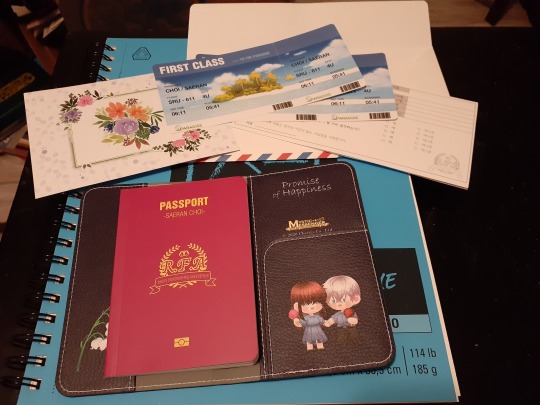
So, we can go over the contents in the box, first as an overview. You receive a letter stamped with a cute sticker as well as the passport itself which holds the notes that Saeran’s been taking and drawing since this all started. I just think that’s cute. My brain said don’t open that passport until we review the letter first so, why don’t we go over the letter first? The little details are really cute. There’s just so many stamps on this baby.
The little touches are what sell it. You’ve got this man putting his love all over it and there’s a CUTE NOTE of CATS. Sir, was that a touch to Saeyoung? I know you know that your brother is a dork. Homage to brother who is an idiot but too glaringly obvious. It got a chuckle out of me. I know this man, and it’s just getting to me.
The passport itself is also really cute. It has the art from the promo banner but instead of everyone hustling around together, there’s new poses and all of that jazz. Jaehee isn’t rushing around. Zen’s got a selfie stick, no surprise on that front. Jumin just chilling. Seven and Yoosung... doing what they do best and you know it. RUN, YOOSUNG, RUN.
Saeran and MC... being cute on the inside made me go, “Aw!” Ice cream. They can really just put ice cream and it’s going to make me cry, huh? Really? Is that how easy this is? Am I a joke to you, Cheritz? Is that what this is?

Now, if you want to talk about the contents in the letter, you get this sheet that is listed in three languages, surprised me, Korean, Spanish, and English, and it lets you tick off little things that you like to do. An itinerary sheet. I feel like this is purely Jumin crafting these. It asks about Cats. Literally. Cats. Wine? Yeah, this is on Jumin. You always come in flex, Jumin, but oh boy, I’m chuckling over here at these little touches.
You get 2 boarding passes. One with Saeran’s name and one with a blank to fill in your name. I thought that was cute. Tying in that with the CG of the passes in the game with this just makes it more real to me. I’m holding this in my hands and it just makes my immersion feel much more real than it did when I was holding my phone in my hand and playing this out.
I think merch like this just makes you feel more apart of the story then you do when you’re able to talk and chat, you know? If you really like feeling like you are involved with the game, this is how you do it. You wanna know how I know that Jumin is the one setting this up with Saeran? Flip over the fucking passport and you realize that Elizabeth is on the back.
I’m still laughing.
I’m trying to imagine this and now, like, I’m starting to see why Jaehee is so damn tired because Elizabeth really is on everything that he can get his hands on and she’s good too many files to sort through when it comes to whatever the photographers take of her. Jumin can’t take photos. He’s either got Jihyun to do this for him at some point, or he’s straight up hiring photographers for her cause he can’t do it.
I mean, we all know that Jumin will put Elizabeth everywhere but I just— It’s on the BOARDING PASSES? JUMIN!
There’s also a postcard within the letter that is once more, written in all three aforementioned languages. Saeran says that it feels like a dream when he is with you, like this is where he’s always meant to be. His promise of happiness is made truest when he’s with you. I teared up a little. I know that he means well when he does that but damn, does it take an arrow to the heart every single time he does it.
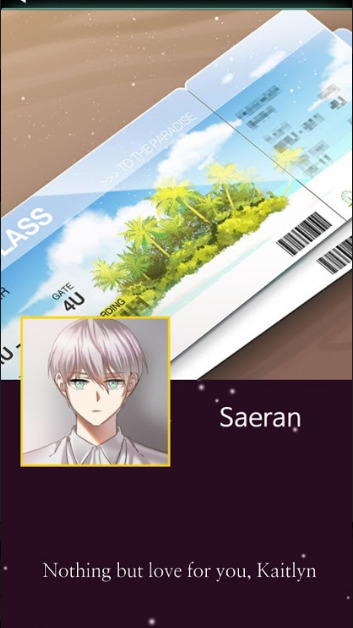
Saeran put a lot of thought into this in a very short amount of time. I know that he did this plan likely with the idea that he may not be able to go with us but he wanted us to be able to see the world for him. You know, how he implied that he wanted Saeyoung to see things for him? To live for him? Even if he was dead, he wanted Saeyoung and the player to be happy and free.
The blurred state on those... doesn’t have names. It doesn’t name Saeran in this photo.
The implication of his sacrifice with the boarding passes kind of hurts because this is a side note of the fact that Saeran Did Not Know If He Would Live To See This Through. He made it thinking maybe.. if things worked out, it would be an okay future, but this was... God. I just. I’m thinking about the weight of the AE and what that felt like. I almost glossed over the Boarding Pass because I was just so upset with him.
I’m the type to try to sacrifice myself for others, too. I have that in common with Saeyoung and Saeran.
I think that we’d argue over who should die for the others and while that’s macabre, it’s just the kind of people that we are. We love these people so much that we’re willing to die if they’re safe and sound. Knowing that, I understand what Saeran tried, and even what Saeyoung tries, but it’s hard cause I want to make sure they’re happy in comparison to myself.
This is where being selfless is a bad thing.

Does anyone know what a big deal it is for Saeran to have a passport? He’s never had an ID or paperwork in his entire life. If he did, he would’ve been killed, so would his brother. They’re both never had IDs. Unless you count the ones from the Agency and Mint Eye. They’ve got them in the Believer box with their names and faces, but that’s not official. That’s not paperwork that everyone else has. That’s just...
You know?
Seeing this tangible thing in my hands is a testament to Saeran Choi being alive and thriving. He’s not afraid of showing his face. He’s living. He’s a free man and nobody can kill him for existing. Does that not weigh on anyone here? It hit me and I wanted to cry. I might break down thinking about this later because I just take this too seriously. Look at him. Look at HIM. Okay? Did you look? Now, LOOK AGAIN.
Okay, I’m not going to share every single page inside of the passport but I will give you little snippets of the journey ahead and show you what he writes and draws. Yes, he’s drawing. I knew that he was talented because he is great at doodling and drawing, but he knows how to have such a cute style that I want to gush about and he probably has no clue about how cute it is because nobody’s ever told him!
Okay, so the trip is broken up over a few months and into segments. You know how I was surprised by the 3 languages? Yes, this passport is written in three languages and it stays that way. It implies that Saeran knows English and Spanish, or at the very least, he’s been studying them, I get that it’s kind of a neat tie in to make sure that all languages are included but I only English and I can only read Spanish, I suck at conversational Spanish, so I could only read the English and Spanish sections.
So, if anyone wants to throw in what the Korean segments say, please do. I have a rough idea, but it’d be nice to know. The first segment of the trip is spent traveling over Korea. You see the things that he packed in the bag!
I almost had a heart attack because I thought the vitamins were Caffeine Pills. I was about to beat my Husband and make him go to bed. Thin ice, Saeran. Thin ice, the Special Believer package implied you take more then ten and I want you to go the fuck to sleep at night.
He packed his hanbok! Look! You remember? From the title screen event? The blue shirt is the one that he matches with MC in. There’s so much I’m screaming about it.
It shows you things that you do. Like, biking, karaoke, gardens... is there a locket bridge in Korea? You know? If you put them together on a bridge, it’s said that your love lasts forever. I forget where that came from but I guess there must be one in South Korea, too. Oh, and food. Can you believe that he can eat whatever he wants now? I’m sobbing.
Please.
HE’S IN HANBOK. AAAAAAAAAAAAAAAAAAAAAAAAAH.

Okay, here’s the thing. I only have one gripe with the Passport Package and I’m going to say this again at the end, but I really wish that they had included big photos for this because the Passport itself it rather small and I wish that I could have bigger photos of this. It’s my only complaint. Literally, it’s the only thing I have to say about the box that will affect my rating. Look, we’re doing cheesy couple stuff!
HE’S DOING THE HEART THING WITH HIS HANDS.
A KISS.
KISS.
GUSHING.
DYING. HELP. ME.
God, I wish I wasn’t broke. I would commission someone to do this for my MC.

The second and third portion of the trip are spent in the U.S.A. and Mexico, I was so surprised by that! New York and Hawaii specifically are what they name and I was. Well, those are really far apart, huh. I mean, those are very popular spots. I’m not surprised. I’m chuckling because he’s got matching outfits.
Saeran Choi, you really want the embarrassing couple look, don’t you? Well, if it’s for you, I’d do it. Did... Saeyoung or Jumin set us up, are we fucking loaded? There’s mad bank here.
Saeran and MC basically are living per Jumin and Saeyoung, to be honest, because Saeran’s never had a job and MC is... your MC literally agrees to go and test a game in the woods, how good can our lives be? I’m broke, boy. I ain’t got nothing. So, I like to think that those two are offering to let Saeran be as happy and free as he wants. No expense. Like, kindness. The RFA is too damn much, I’m gonna cry. I’m starting to understand why the RFA didn’t hear from us for months.
The final Check-In with the RFA is set 6 Months after the events that take place when we save Saeran. The events of this Passport cover 3 months. So, we go back to Korea after this adventure and met up with Saeyoung, because we know that we’re hanging out with him in the conclusion. So, if they haven’t really heard from us, that means that we’ve been traveling more with him.
I kind of like that.
We’re spending time with Saeran alone and time with the brothers together, and that’s sweet! I love that. I need to write more about it.
I’m trying not to laugh about this Mexico portion but it looks like he passed out from an ice tea... lemonade...? It’s surely not alcohol. Maybe too much sugar, I know that crash can hurt. I’ve been there. I just know that you’re not implying the man with alcohol trauma is gonna drink. Nope. Neither he nor Saeyoung ever will do that. I stand by that statement and I’ll die by that statement. Bite me my tongue if I’m wrong, but I stand by that.
Saeran is at least mindful of the sun. He’s also made notes that the perfect time for sunset is 18:34. Cute. He notes that it’s time for the Day of the Dead as well, so that’s fun!
IS THAT A FUCKING V CACTUS—
TWO V CACTUS—
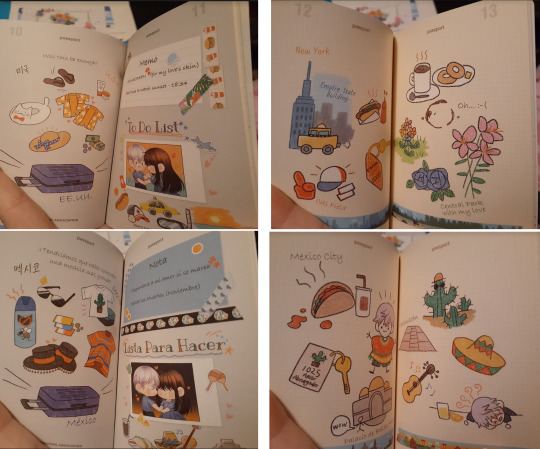
There’s actually a portion in here where he asks you certain questions and you have the space to fill in it. I like that it’s interactive.
Do you have favorites sweets? Are there things about yourself that you hide? Did you make sure to ask Santa what you wanted? I’m wheezing. The food doodles are one thing, and the Christmas photo is one thing, but he really drew himself as a butterfly and the MC as a bug catcher.
“CATCH ME, MC.”
Help me.
I’m laughing so hard.
Saeran, you fucking goofball.
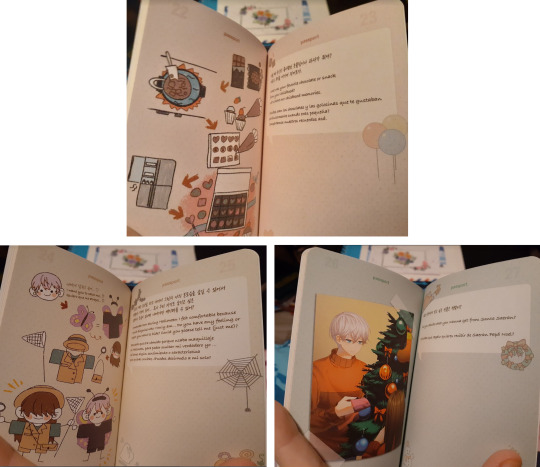
And, the last page of the passport is us assumedly returning home with all kinds of trinkets and gifts. Flower crown, snow globe, cactus, hats, listen, there’s a lot of details in this photos that I really wish I could have it blown up.
That’s really my only complaint about the Passport Package. I really want to have bigger photos that are shared. I wouldn’t have minded if it was the photo of the final CG in the game, or the Christmas photo, I really would have enjoyed getting that to have for myself.
You know? The passport itself is roughly like 5 x 7 or so, so while it’s not big, it’s still like. I would love to see the details blown up. It’s smaller then the diary, that I know for sure. I think it’s the only thing stopping from giving Cheritz a 10/10 on this item.
I’m going to have to give them a 9.8/10 simply because it feels like we are lacking one big photo.
I guess I’ll print my favorite CGs and decorate my room like that. But, all and all, I really enjoyed reading this and it made it feel like I was there and I was able to reflect on Saeran’s vacation with the player. Like, he was doing this as we were going using his little doodles... I’m in love with this fucking sap. I’d say that this is worth the money.
For sure.
My only gripe aside. That’s a personal problem, not really a content problem. I love this bastard.
Look at him, he’s GOT A PLUSHIE. I have so many things that I want to write about now thanks to this. Saeran, darling, sweetie, my love, I am dying. Either way, I’m glad this arrived when it did. I needed this. I justified getting this for myself because I don’t expect to get anything for my birthday in early February but I’m happy I have him.
It’s been five years since I found this game in August 2016. I’m happy that it’s been here with me.

#SaeranAfterEnding#saeran ae#saeran after ending#mm#mysme#mysticmessenger#mystic messenger#mystic messenger saeran#saeran mysme#saeran mystic messenger#saeran mm#mm saeran#mysme saeran#saeran#saeran choi#choi saeran#saeray#ge saeran#mod kait#spoilers#spoiler#long post
213 notes
·
View notes
Text
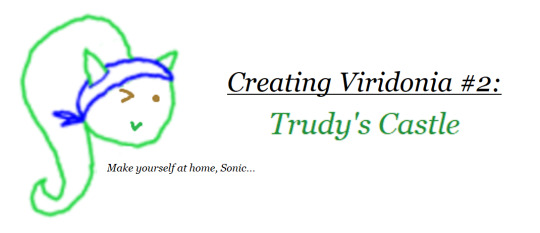
When taking Lutrudis as a concept into account, it could be argued that the decision to have her live in a big, fairytale-like castle would be an unwise idea, maybe even counterintuitive, since a place so extravagant might undermine her intended loneliness and yearning for a more fulfilling life, adventure, and all that jazz before Sonic and company entered the picture. The last thing I’d want with Trudy would be to remind people of Chris “woe is me” Thorndyke and his rich kid mansion lifestyle. Not to mention that since some of the townspeople in Lime Shores can act rather ignorant (and in some cases, antagonistic) towards her, a lavish castle might also undermine the underdog nature of that particular setup.
Despite these concerns however, I felt confident with my plan, and I figured that as long as I knew what I was doing, readers would understand what I had in mind. I’ve explained in the past that a castle would better accommodate someone with her EDS, so right off the bat, you already have a practical justification for it. It also helps that whereas the accursed Thorndyke had his parents, friends, grandad, butler, etc etc etc etc... Trudy genuinely had no one to turn to before the heroes arrived for their intended vacation. So with that said, let’s examine this particular building for a bit, complete with pics for comparison’s sake, as well as a certain cavern full of Ethereal goodness that happens to be nearby...
Creating the Residence: Trudy’s Castle
Let’s get the obvious out of the way: The outside environment is not too subtly inspired by Autumn Plains from Spyro 2, better known to non-Spyro fans as my blog background.
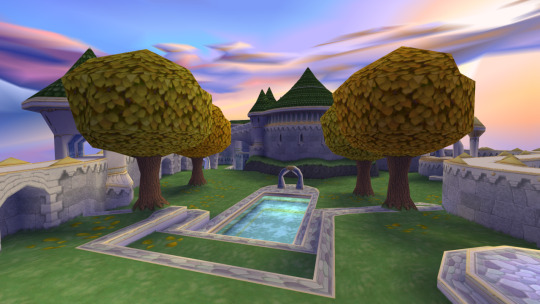
A serene yet lonely autumnal forest backdrop, with a big stone castle smack dab in the center. It’s not one-to-one the same of course - instead of a pool, the front area boasts a lovely garden full of different flowers, and there’s also a lake nearby - but the mood is more or less what you see here.
However, this partly serves to contrast with what’s behind closed doors. As acknowledged in Beyond the Stars proper, the interior of the castle instead goes for a different and grander, yet equally inviting atmosphere when you take that first step inside. Instead of stone, you see marble and wood, and instead of grey and green, you have reds, creams, maroons, and golds (with a few complimentary blues and purples thanks to the flags hovering above).
As the lady herself mentions, Trudy discovered that the interior was in a state of disarray when she obtained it, and she was of the belief that a castle as beautiful and rich in history as this one deserved better than to be forgotten and wither away in the coming generations. The least she felt she could do was give it a modern, yet respectful redecoration, and give the old building a second, loving life in the process.
Yes, that means every spot of detail inside this castle was done single-handedly. Entirely on her lonesome. It took ages to complete, especially when taking her EDS into account, but she was determined to give the place its due, and lo and behold, the effort more than paid off. (You know, such levels of determination bring a blue hedgehog to mind...)

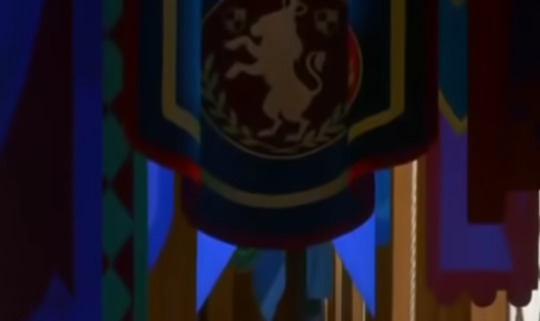
And that’s just the intended vision for the main hallway! We haven’t touched the other rooms yet! (Since a castle would have quite a lot of rooms, it goes without saying that for the sake of keeping this post from going even longer, we won’t be covering literally every single room... just the most important and/or most noteworthy ones. :o)
The bathroom can be described as a mix between the two examples below, combining the semi-medieval build of the former with the sky blue palette and general relaxing style of the latter.


Though that said, while the bath remains there for any guests to use, Trudy personally uses a shower since it’s more convenient for someone with her condition.
The kitchen (or as Sonic likes to call it, “the palace of chili dog magic”) mostly comes in cool browns and blacks, and its intended appearance is probably one of the more obvious combinations of old-timey and modern. It also has a slightly country aesthetic compared to the other rooms, because ha ha, horses, geddit.


The greenhouse at the back brings back the heavy amounts of green (well duh, the clue’s in the name, isn’t it?), while also providing contrast with the whiteness of the structure and architecture. Complete with giant arched windows, because of course.



And the segue point between the greenhouse and the rest of the castle looks something along these lines, at least with the way the building itself connects.

Even the chambers underneath the castle manage to look classy and clean. And just as well, since it’s where Tails parks the Tornado for the remainder of his time in Viridonia, once he FINALLY remembers to get it off the Lime Shore beach...

You know another benefit of such a spacious area? You get to turn it into a makeshift workshop for all your gadget needs, Tornado-related or otherwise. I’m sure that won’t come in handy at some point...
The guest bedroom is one of the most curious rooms of the lot, because even though it’s as nice and tidy as you’d expect, it’s also rather... muted compared to everywhere else. Perhaps Trudy felt no need to modify it further in any specific way, since no one had ever bothered to stop by anyway... until you-know-who and the gang.
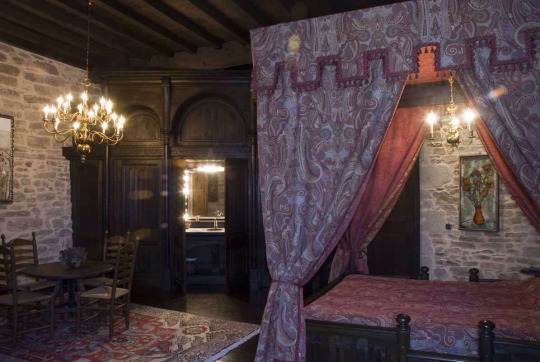
And we can’t forget to mention our fair equine’s OWN bedroom now, can we? Her bedroom opts for darker colours, yet no less therapeutic, which includes the canopy bed that she rests in. You can actually see the general idea with the bedroom (and the outside of the castle for that matter) for yourself, in the Dame of the Daisy mini-comic, courtesy of my awesome friend @benignmilitancy.
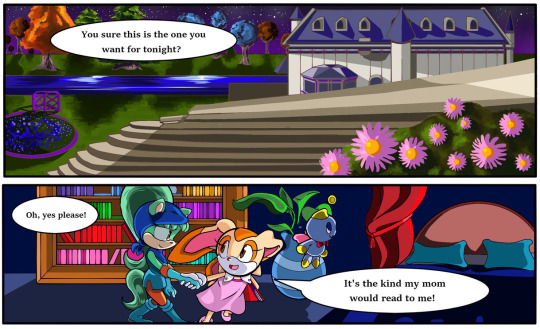
Likewise, although this shot is currently incomplete (don’t worry, Benign is fine with me using it :P), meaning some details haven’t been added yet, you can also get a basic idea of how the balcony is supposed to look here, along with the complimentary view of Viridonia’s oceans.
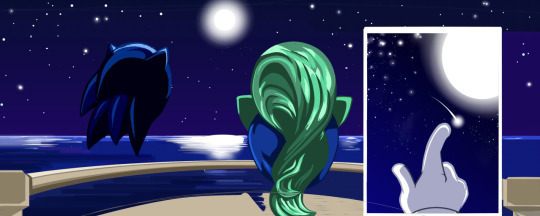
So what kind of music would befit Trudy’s castle, you may ask? Well, taking every detail into account, we would need something that goes for that perfect mix of adventure, wonder, warmth... and a faint hint of sadness lurking beneath. Something that gets all four across, but not in a generic, run-of-the-mill orchestra sort of way. Something a little more ambient and down-to-earth, with a more unique and specific kind of intimacy. Something like...
youtube
youtube
This would apply for when you’re inside, mind you. Outside the castle, the surrounding forest would have a theme of its own, though it would share that similar combination of melancholic friendliness. So for the outside, we would go with something more like...
youtube
Overall, the idea behind Trudy’s castle - aside from being her residence and looking enviously pretty - is to add to Trudy’s own character. It’s said that one’s home can say a lot about a person, and I made sure that every room shared a consistent narrative when reading between the lines. They may differ in shape, and they may even differ in colour, but the story is kept consistent at all times. We know that our girl is elegant, we know that our girl has slightly antiquated tastes... and we know that until the arrival of Sonic and Co, our girl was extremely lonely, and isolated by her peers, to the point of staving off said loneliness and isolation by making the place as lavishly detailed as it is in the first place. And just as the stony exterior hides the more fanciful interior, so too is there more to Trudy herself than at first glance.
Besides, not counting Eggman’s endless list of tributes to himself, we don’t often see the characters’ homes in the games, do we? We’ve seen Angel Island for Knuckles, the Space Colony A.R.K. for Shadow, that shack belonging to the Chaotix in Heroes, a few pads of varying consistency depending on the game (Tails’ workship in SA1 VS his house in Battle)... but not much more than that. And what better contrast to Sonic being something of a nomad, than by Trudy living a place like this?
But we’re not done just yet. Last but not least, we can’t forget that mysterious cave hiding down below, where countless amounts of Ethereal Crystals can be found undisturbed... You can bet that such a place would be suitably attention grabbing.
Since the crystals themselves come in practically every shade of the rainbow and then some, the resulting combination - specifically their reflecting shine - ends up painting the cavern walls with just as much colour.



It may feel a tad surreal and almost alien, to the point of being a little intimidating for some, arguably. But you know in your heart of hearts that as long as Eggman isn’t in the equation, there is no need to be fearful. After all, Trudy knows it better than anyone else, and although the crystals and their properties may hail from unknown, possibly uncomfortable origins, the horse herself continues to use them for wholly benevolent purposes.
Such a cavern would deserve a theme of its own, no? We’ll need something that drives home the point that the power within has no inherent morality, and can only be as good or as evil as the person using them. So although Trudy’s own intentions are firmly on the side of good, we’ll also need an added touch of minor eeriness lingering in the background, to represent the overarching threat and subsequent implications of Eggman dipping his own hands into the metaphorical Ethereal well, on top of its already unexplained otherworldliness...
youtube
youtube
So yes, it’s quite a pleasant castle that Trudy has, eh?
But this isn’t the only castle that can be found in Viridonia...
Well, it used to be the only one of its kind on the island... until a certain doctor stopped by, decided to beat the horse at her own game, and create his own, darker counterpart in response... But we’ll get to that when we get to that, ho ho ho.
16 notes
·
View notes
Text
Okay I’m going to try and explain it because it was so VISUAL and SPECIFIC and it won’t leave my brain:
The whole thing was animated like a synthwave music video, lots of blues and pinks and purples. This was episode three or four in a New MTL series, every episode focused on a different bandmember going on some kind of Quest to unlock his Godhood and discover his True Powers. The previous episode was about Nathan and this one was about Skwisgaar. They were riding in a speedboat driven by a Church of the Black Klok member: She had long back hair and red goggles and was kind of dressed like Audrey from Atlantis and was voiced by Real Life Voice Actor Nika Futterman (the voice of Smellerbee in ATLA and Olga Pataki in Hey Arnold!) doing a soft French accent. Nathan was coming along since he’d unlocked his powers and was going to help Skwisgaar find his. (I think as each band member found their powers they would go along with the next one to, gradually building and developing their powers as a Group.)
This is where it gets a little murky. They were driving out to some kind of cave system and CofBK Girl said they were close. While they’re riding there’s this elaborate opening credits sequence overlaying the scene. First it was this big block lettered font reading things like THE FUCKING COOLEST MOST KICK ASS SHOW OF ALL TIME IS BACK. But then it transitioned to showing (in the dream) real life works of romantic art through the centuries so the implication was Skwisgaar was going to discover he was the God of Love or something. (In the dream at this point I rewound the episode to rewatch this sequence and it changed slightly, the original art was there but so were other pieces that were more broadly about celebrating life, as well as an article in the New Yorker written by Albert Einstein that was accompanied by JAZZ for some reason.)
Nathan unlocked his powers (something water related) but he was still getting a handle on them. Then...something happened. It was unclear but either his powers glitched or Salacia/some dark force/The Plot got in his head and the scene cut so instead of looking at Skwisgaar on the speedboat he was looking at Skwisgaar and Toki sitting on a sunny beach. (I think Toki’s episode would have been next.) Nathan seems to think that’s where he actually is, but then the scene cut back and Nathan had actually pulled a wall of water up over himself and was drowning. Skwisgaar was screaming at him to stop but it was like there was a solid glass barrier between them, he was pounding on it and making no impact. Then the CofBK lady threw a purple gem at Nathan and he was fine? I don’t know.
They got to the cave system and then I woke up. I am almost certain Nathan and Skwisgaar would have kissed by the end of this episode. Also you guys should have seen how beautifully this Skwisgaar was animated. Gorgeous. Angelic. Quite literally the Skwisgaar of my dreams.
Had another dream about a new episode of Metalocalypse…this one was Nategaar Focused…
#metalocalypse#i kinda wanna do something with this but i don't know what#maybe i can use the CotBK lady in something she was cool
14 notes
·
View notes
Text
54 Ships And Counting: Transformers
This one is a gift for @kaijulover142 who was looking for a little TFP Ratchet/Arcee! I hope you like it ;v;
6. Ratchet x Acree
~it’s been a while, hasn’t it?~
Ratchet could do all the cursing and grumbling he wanted over the stupidity of the wound which easily could have been avoided, but he knew Arcee wouldn’t listen. So he silently glared at the work in front of him; her shoulder, completely torn open by some stupid overcharged idiot with a-
“It’s been a long time since I’ve had you as my doctor…” She muttered dazedly, mind somewhere else.
Those words gave him pause, memories from long ago filtering through his processor before he promptly shut down that train of thought.
“I could’ve lived never seeing you with an injury again…” He mumbled softly as he finally sealed up the plating.
Arcee began rising and was about to get off the medical slab, “Nah ah ah, I’m going to smooth out that soldering scar! I’m not letting you walk around looking like that.” The second part Ratchet mostly spoke to himself as he went about grabbing the things he needed.
As Ratchet set to work making her armor look nice again he could feel her optics on him, a sensation that long ago would have made him uncomfortable, now it only perplexed him. Pausing he looked up to make optic contact and found Arcee staring at him thoughtfully.
“We should go somewhere, just you and me.” She smiled as if remembering an old joke that you’d forgotten for years.
Ratchet blinked owlishly at her, “What?”
“Not right now obviously. After you get out of work, maybe we could….go for a drive.”
The implication in her words made Ratchet’s old fuel pump do backflips. And then he was having the same realization he was sure she had also just had.
The war is over.
A particular memory zings into the forefront of his thoughts. An old cave on earth, an expression of emotions, and an agreement to not let them get in the way. He returned his attention to her shoulder to add the finishing touches as he let everything sink in. When he pulled back he sighed.
“You’re right, it has been a long time, for a lot of things.” He sounded tired as the words left his lips.
Ratchet turned and walked away and began putting away his tools. He barely noticed as she hopped down and walked over to him until her servo was on his shoulder. He glanced back at her, her expression serious.
“Ratchet, I’m obviously not going to force you to do anything you don’t want to, but regardless of what comes of it I think getting out with someone familiar would do you some good. I’ve heard you’ve been keeping to yourself a lot these days, people are worried. I’m worried.”
Ratchet’s first instinct was to snap at her, tell her to mind her own business, but that’s his first instinct with everyone, and Arcee is not just anyone. Though his temper roiled just at the edges of his person he took a deep calming in-vent and let it out very slowly. He was still inclined to refuse the offer, but something in the way her gaze softened, the way he could tell she knew he was getting agitated; it poked at something deep in his spark.
He spluttered for a moment before giving an exasperated grumble, “Fine, I get off in two hours. Then you can take me where ever you like.”
Arcee smiled gently at that, “Where ever I like? I’ll keep that in mind.”
As she turned to leave Ratchet found himself watching her walk away, an odd and unfounded anxiety bubbling in his tanks. If he was a tad short with the rest of his patients they knew him well enough not to point it out.
Stepping out of the medical facility and into the chilly night air would have usually worked out all the kinks in his stressed and tense joints, but considering Ratchet’s predicament it did nothing but make him stretch his cables more taught. It only took a bit of short cursory glancing to catch the gleam of her blue armor in the light of the street lamps. Arcee was sat patiently on a bench across the street, she’d already noticed him it seemed and was standing to come join him at the foot of the steps.
“Well then, where are we off to?” He tried to sound less grouchy, it didn’t work obviously because she laughed.
“Relax Ratchet, when have I ever walked you into a trap?” she paused and then amended, “On purpose. We’re just going for a drive, a little ways past city limits I figure. Somewhere quiet where the stars aren’t framed by buildings when you look up.”
Ratchet blinked, marveling slightly at the simplicity of her choice. Not only that it came from Arcee but also because something in the back of his mind commented that it sounded nice. “Quaint.”
She turned to him then, quizzical look on her face, “You have a better idea? I didn’t exactly peg you for a night on the town kind of mech.”
Ratchet scoffed, “At my age? At this point in my life? I’d make a fool of myself.”
Arcee began walking and gave a motion with her hand for him to follow, stepping out onto the road and transforming. “But in the past? Would you have chosen differently if you were younger?”
He followed suit and remained silent for a moment as they began driving. He wasn’t so sure how much he wanted to talk about his younger self. The young medical student who had still yet to witness all the horror the universe could offer. He relented though, feeling comfortable enough that no one else was listening in, “This may come as a surprise to you, but I was a stupid young bot once and I did happen to enjoy dancing.”
Arcee’s headlights brightened momentarily at that, likely in amusement judging by the tone she took afterwards, “Really? You? Dancing?”
Despite himself he found a chuckle tumbling out at her amused and vaguely dumbfounded response, “Yes, I danced, and I wasn’t half bad either. Not that I would ever go up against Jazz, especially not at this point. I held more prowess in slow dancing anyway, things that required more thought and delicacy.”
“I could see it.” Her tone was far too soft then, as if she very well was imagining him in his younger days slow dancing with other young but perhaps better looking bots.
The rest of drive was blissfully quiet, and in the rhythmic beat of his tires on the road and the soft but present EM field beside him, he found himself relaxing. Everything he’d pulled too tight during the day finally let up, all his joints held stiffly settled into a resting state. He felt more relaxed than he had in quite a while, and for a moment he regretted his earlier snippy behavior and near refusal of this opportunity to spend time with someone who had once been almost more than a friend. He didn’t have it in him to break the silence and make the moment more heavy than it needed to be, so he reached out with his field and ghosted it against Arcee’s. A silent thank you and a gentle apology.
He was glad she didn’t react physically or verbally to the sudden intrusion of her “space”, but it was perhaps no less startling when her field tangled with his as if in warm embrace. Feelings so soft and warm and welcoming washed over him, and he felt himself drifting closer to her minutely.
Finally past city limits and out on the wide open road Arcee slowed and then gently moved off the road before transforming back into root mode. Ratchet followed the example and walked beside her as they approach a hill and climbed up the gentle incline until it leveled out. New Iacon behind them and another city just barely visible in the distance, and above them….the entirety of the sky.
Ratchet stood there just looking up into the black velvety expanse with glimmering pinpoints of light. It didn’t even register that Arcee had placed her servo in his until he noticed himself reflexively squeezing it gently. He slowly glanced down at their clasped hands, bringing them up closer for inspection. Her slender digits, gently laced between his larger more blunt ones. There was an odd calm in looking at the way her servo seemed to fit his, even if the notion was romantic nonsense, he’d let himself think about it a moment longer.
The warm glow of her optics caught his attention next. She seemed to be mirroring the odd calm he himself was experiencing right this moment. She didn’t hold his gaze for long, casting her eyes back up to the sky then down again as she un-subspaced something. It was a bottle of Engex, to be more specific, it was Ratchet’s preferred brand.
He snorted at the sight of it before giving her a playfully stern look, “Been snooping have you?”
She laughed lightly, and it was an oddly pleasant sound on his audials, “Sorry to disappoint, but I didn’t do any espionage for our date. I remember you telling me yourself that you liked this brand. It was a long time ago though, so I’m glad I picked right.”
Energon pooled behind Ratchet’s faceplates at the idea that even during the war Arcee had found the time to remember his preference of Engex. She handed him the bottle and then unlaced their fingers, producing two glasses. He found himself missing the contact immediately, but gladly took to opening the bottle and filling the two glasses. He took his glass and made to hand back the bottle but she stopped him.
“Keep it, it’s your favorite after all.” She spoke with a soft smile.
He nodded his thanks and subspaced the bottle. She held up her glass then, “To peace time.”
“To peace time.” He nodded and touched his glass to hers before tossing his drinks back swiftly.
He chuckled when he looked back and she was making a face, “I suppose I should’ve warned you about the burn.”
She coughed and cleared her intake, “Maybe.”
The two laughed then, a genuine laugh and for the first time after the war had ended Ratchet genuinely felt like everything was going to be okay. As it died into giggling and then back into silence, the two of them smiling but not quite making eye contact, Ratchet had a thought. He took her glass and his and set them down on the ground before holding out his arms. She looked at him, clearly confused and he rolled his optics.
“I may not be as good as I used to be, but I promise I won’t step on your pedes.”
Realization dawned in her optics and she smiled, stepping up and taking his servo, her other going to his shoulder. As his other servo came to rest on her waist and they began moving she came to realize she was experiencing a side of Ratchet likely no one else had in a long time, and she felt suddenly humbled. She could tell he was keeping the movements simple for her, so she could follow along easily and she was grateful for that. But beneath that she could easily see the experience in his movements, the control and lingering fluidity of someone who used to do this all the time.
He spun her and then pulled her flush against his chest plating and despite he being the one that did it they both looked startled by the sudden proximity. They stilled and merely looked at each other, the wheels seemed to be turning in Ratchet’s processor.
“Hey Ratchet?” Arcee questioned quietly, “No regrets?”
He smiled.
“No regrets.” And the space between them vanished.
28 notes
·
View notes
Text
10 anime staples integral to anime
Ignoring Buzzfeed’s focus on whatever’s popular right now; I decided to throw together a list of 10 anime that, regardless of anything, are shows considered mandatory if you are someone who watches anime.
Even at my old job, it seemed the only thing people had any focus or knowledge of was what had come out in the last 3 - 5 years. And ignoring my feelings about modern anime, this is not an accurate reflection of anything to do with the medium. And if you tried to discuss “anime” as a topic, you’ll find yourself very quickly being completely out of touch with other people who watch anime. Unless you ONLY focus on a specific fandom for one specific show.
But Some anime ARE staples of the medium. And regardless of personal taste, animation quality, how dated they might be now or popularity, some anime remain staples. And if you’re someone whose “Never Seen Anime” like the Buzzfeed article would like to suggest, you’ve got a much better chance looking to the titles that make up the foundation of the anime “fandom” than looking at whatever came out in the last 5 years or what’s trending on twitter or whatever the kids are into these days;
I chose these based on this. Not on my personal taste, or even popularity. But purely on their presence in the anime realm as a whole. I’ll even admit I might not even like all of these... But they remain staples. And even if you don’t sit down and watch them, you are required by anime law to at least know OF them.
1: Akira (1988)
The big one. EVERYONE knows about Akira. People who don’t know anything about anime know about Akira. People who don’t know about Akira have SEEN images and iconography from Akira.
Heck I don’t even like Akira that much. I don’t even think it’s that well adapted into a movie.
But I have seen Akira.
EVERYONE has seen Akira.
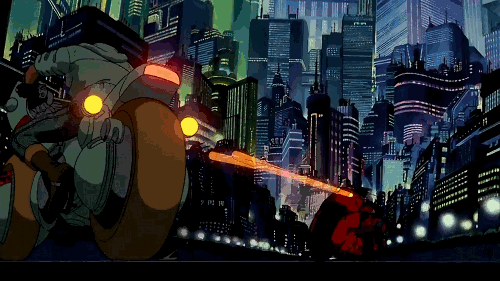
2: Cowboy Bebop (1998)
Almost always in the top 3 of people’s “top 10 favourite anime” lists, if not number 1. But Cowboy Bebop is not merely a “popular” anime. Often cited as being better dubbed than in its original sub, Cowboy Bebop is a medley of different genres, mostly inspired by Westerns, Gangster movies, as well as Jazz and Blues. Cowboy bebop is an anime anyone can access, even if they have little to no exposure to anime. Cowboy Bebop is very very easy as a starting point. But also has some of the most three dimensional flawed characters you’ll find in anime if not most television. Cowboy bebop succeeds because of its humanity.
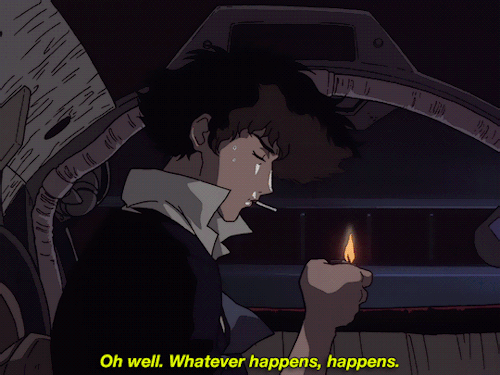
3: Trigun (1998)
Often coming hand in hand with Cowboy Bebop if for no other reason than the fact that they premiered in the same year and both share a strong influence by Westerns. Trigun might not have the gut-punch existentialism of Cowboy Bebop, but is still considered one of the best animes released. A weird mix of Westerns, Mad max and sci fi, Trigun succeeds based entirely on its main character, Vash. Trigun as a show is more than anything a character study, as well as being a commentary on just how hard it can be to be a pacifist and how much courage it takes NOT to shoot, rather than glorify violence, and equate “bad ass” with killing.
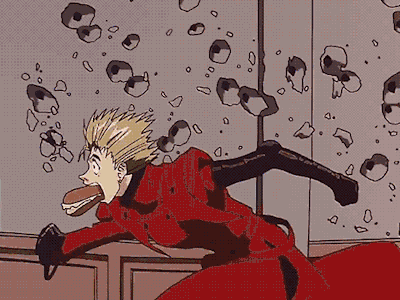
4: Neon Genesis Evangelion (1995)
*siiiiiiiiiiigh* Ok... So here’s the thing;
Eva is the black hole of anime. There is no escaping Eva. For better or worse, Eva is an all encompassing cloud over all of anime. And pretty much was the second it aired on Japanese TV. What started as a “giant robot” anime that explores how much being in a giant robot can mess up a kid (not new to Eva, in fact this is pretty much the basis for the first Gundam anime) but quickly devolved into a monster of a show. Its creator... well.... kinda lost his mind as the show went on. And it showed... it showed HARD.
The show went from a dark giant robot anime into an existential nightmare, exploring doomed characters in an apocalyptic situation as humanity slowly tumbled towards its destruction. Mixed with the main character, a truly hateful person who was written specifically to BE hateful, and his broken psychosis, the trauma of puberty, deep and inescapable depression, and his reaction to the people around, all of who also are written to be unlikable at least to a point if not completely detestable.
And then on TOP of this, Gainax (the studio) decided to use Christian visuals to give the anime a “stylistic edge” among the rest of anime being released at the time. Not considering the implications the Christian iconography would have for the western audience once it released overseas.
It reached a boiling point climax with the last two episodes in the series taking place entirely in the main character’s mind. This causing many insane fans of the show to send the director death threats for “disappointing” them. And then LATER causing an entire movie to be made called “the end of Evangelion” which was the ACTUAL end of the story... And now there’s like new movies being released as well to this very day and I have no idea how they even fit into this whole mess?
But Eva is a neutron star, collapsing in on itself. And it doesn’t matter if you love Eva, hate Eva, or are completely indifferent to it. There is no escaping Eva.
It changed anime forever. And there’s nothing that can be done about that.
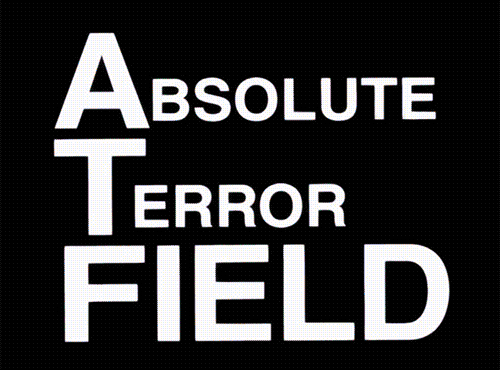
5: Mobile Suit Gundam... like.... ANY Gundam. (1979 - current)
I can’t remember where I heard it, but someone once described the level of impact Gundam has and the level of fantacism from its fans as being the Japanese equivalent to Star Trek. And really that’s the best way to describe it. Starting in 1979, Gundam took the “Giant Robot” concept and instead turned it into an allegory for War. Gundam, regardless of which series you watch/read is always a mix of Shakespearean drama and the horror of war.
Hell, This is a... THING so important to Japanese culture that the country decided to build a LIFE SIZE replica of one. Part of Japan’s Self Defense forces are codenamed “Gundam”!
Probably a little difficult to approach as a westerner, but one should at least be AWARE of Gundam if nothing else.
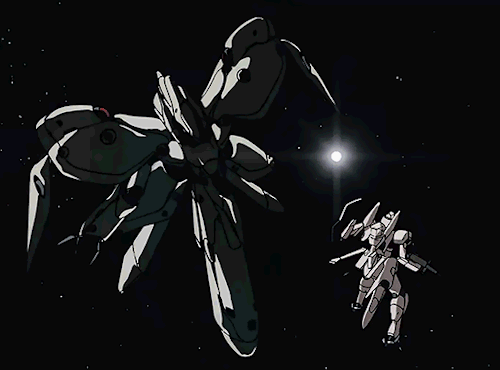
6: Fullmetal Alchemist (2003) or Fullmetal Alchemist Brotherhood (2009)
In my mind FMA is still a “recent anime”, but seeing it actually aired in 2003, I guess I can’t make that statement any more. FMA is a series that, despite being insanely popular when it first came out, only started gaining traction as a real “Classic” within the medium after its second adaptation “brotherhood” probably finished. I’ve heard many people say Brotherhood is better, but having only seen the original, I can tell you if Brotherhood is better it’s probably one of the best damn anime ever made since FMA on its own was already no small contender.
I can probably blame this show as the start of my ongoing existential crises when I first watched it around 2004 or so.
A difficult one to pin down compared to the others. I think FMA has such lasting power because it’s a mix of a unique setting and ideas, has extremely strong world building, has a lot of political intrigue, but at the end of the day, just like Cowboy Bebop and Trigun, it’s its characters that keep it strong. Whether it’s the brotherly ties between Edward and Alphonse, or their relationships with the characters around them, or their loss and ways in which they’re prisoners to their past, or its the sheer weight of the drama, both personal and on a worldwide level that they go through. Something about FMA’s characters elevates it so far above so many anime, as well as its absolutely perfect story progression. I remember this is the first time I watched a show where, in the second or third act, I remember longing for the earlier episodes... where the characters were happier and life seemed so much simpler.
Whereas a few years ago I’d still be calling all this “popularity”... it’s getting to the point now where its long lasting impact can’t be ignored, and it deserves being recognised as a medium classic, rather than just “really popular”.
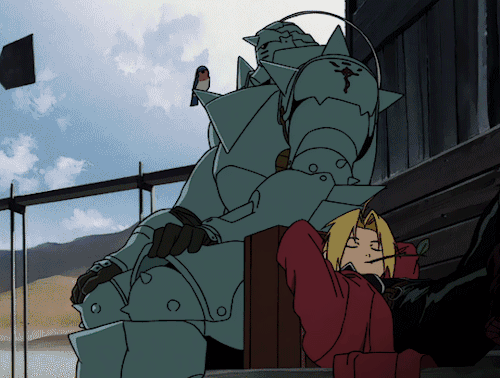
7: Visions of Escaflowne (1996)
A weird one this. Visions of Escaflowne is a show that doesn’t come up in conversation as much as the others, but if you talk to anyone who’s more serious about their anime, they’ll be aware of it and know of it among the “classics”. Escaflowne is very similar to the shows above in that it mixes genres. It’s a “giant robot” anime, however it is unique in being a giant robot anime that takes place in a fantasy setting. A setting one would more associate with mages and dragons, Escaflowne has those.... and then also giant robots. A mix of a much more western idea of fantasy, political drama, as well as a coming-of-age love story (with giant robots) and a fish-out-of-water story as our main character is a girl from contemporary Japan, caught up in this fantasy world’s politics.
Escaflowne was originally planned and written to be 39 episodes, but after a very difficult production time, it ended up being only 26 due to budget reasons. As a result however, there is VERY little time wasted in the show. Probably the only anime in existence where there literally was not a single second for any kind of “filler” because it had to condense its plot into the shorter frame. As a result, the show focuses only on the very most important points of its story, and its characters. No moment is wasted or feels like it’s just there for no real reason.
It’s a story that never puts on the brakes, because it simply cannot afford to. And for a show supposedly cut down due to budget... it damn well doesn’t LOOK like it’s got a small budget. damn.
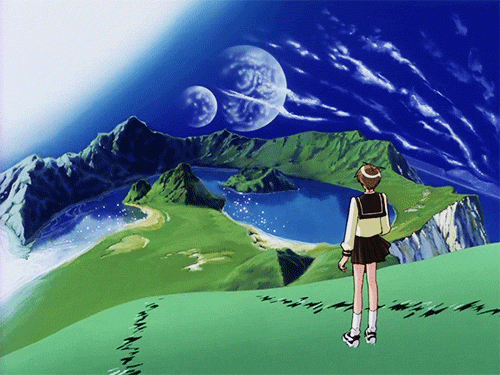
8: Ghost in the Shell (1995)
Another Big One.
Ghost in the Shell can probably be contributed as being one of the major forces that made the West take more notice of anime. Anime had been slowly creeping to the west since the 80s with VHS becoming more widespread, but Ghost in the Shell marked a point where people started realising there was more to Japan’s animation than “violent Porn Cartoons”. Although still not main stream, Ghost in the Shell was at least a major factor in making people realise that Anime had some serious weight to it.
I tend to describe Ghost in the Shell as more of an essay than a “movie”. Although it has a “plot”, the movie’s main focus is in exploring our main character, a cyborg called Major Motoko Kusanagi, and her struggle trying to grasp her own humanity. Or what is left of it. Being in a completely artificial body with only her brain surviving as her “human” part. The movie is primarily interested in her questions of whether or not she’s still human, and where exactly does the line for “human” begin and end.
Accompanied by a haunting musical score, often including traditional japanese religious chants, and Mamoru Oshii’s atmospheric direction, it’s gone on to be a major influence on most modern sci fi, as it itself was influenced very much by Blade Runner and continues with the themes set up by the Ridley Scott film.
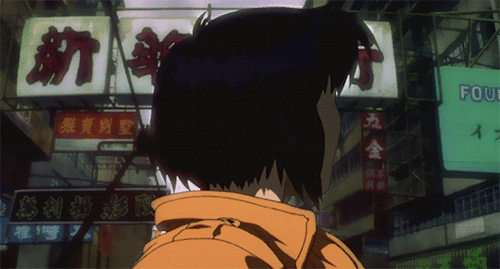
9: Rurouni Kenshin (aka Samurai X) (1996)
Rurouni Kenshin has more in common with live action Japanese cinema than it does anime... to a point at least. Kenshin is, at its heart, a chanbara. That is, an anime (or film more typically) focusing on samurai in historical Japan. Kenshin however, has no interest in being 100% historical accurate, as a lot of its characters are inspired by arcade fighting games.
Also noteable, despite being a chanbara, Kenshin’s time setting is not the Edo period, but instead the Meiji period (roughly around 1868) a period of time where Samurai were starting to die out as Japan slowly opened its doors to the west and western development. During this period it was illegal for anyone apart from Police to carry swords any more, and the story takes place a few years after what is historically known as the Bakumatsu. A short but violent civil war marking the end of the Edo period and the beginning of the Meiji, where the Shogunate ended and the country returned to Imperial rule. A setting which is important not only for its world building but also for our main characters.
A mix of historical drama, and typical “shounen” beat the bad guy, a love story, a tragedy, a comedy and a lament for a time now lost, The Kenshin manga has not only been the source for the anime, but also 2 animated motion pictures, 2 OVAs, 2 live action movies (with a third I believe still coming), several stage plays, light novels as well as 5 video games.
Also the orchestral soundtrack (that is not the jpop used for the intros) is some of the best damn music television anime has ever had.
Also seriously this...
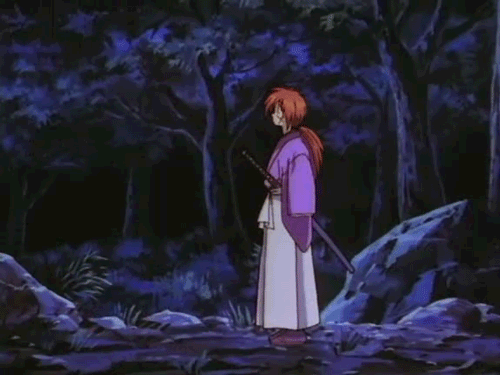
And this....
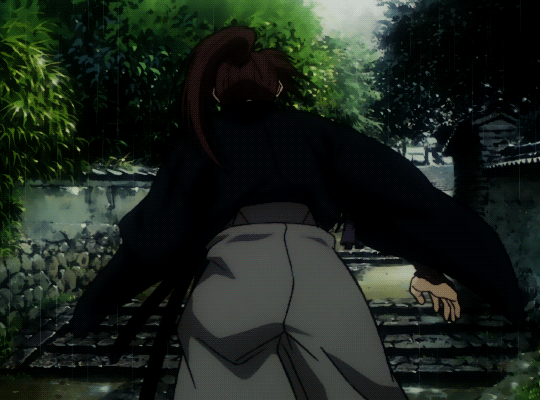
Are from the same story.
How am I suppose to find a single gif that can encapture all of the emotions in this show from the ridiculously silly to the soul crushing heartbreak???
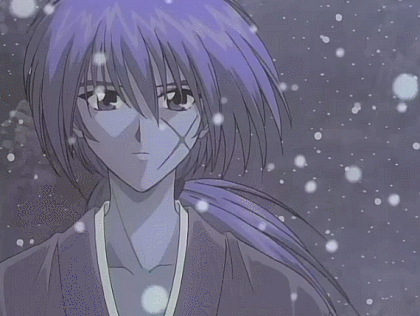
10: Tenchi Muyo! (1995)
Tenchi Muyo is a weird one. Because Tenchi Muyo started out as an OVA, and even as an OVA its first episode is completely and utterly different from its last episode. Characters’ personalities in episode 1 seem completely different to every other episode. That’s because they were basically writing this show as they went along. And yet, through sheer grace of its characters and its setup, Tenchi Muyo is not only a staple of anime today, but has a hardcore fanbase and countless adaptations into other anime series, OVAs, light novels, Video Games, Audio Dramas, movies and manga.
So what is it? Well, technically, as in TECHNICALLY it’s a harem anime. A harem anime is typically about a single “everyman” male main character who finds himself living together with several female characters through weird circumstances. Usually its typified that there’s a chance that ANY of the female characters will end up with the main boy character, but there’s usually also a “main” girl character who the audience more or less knows he’ll end up with. It’s kinda a weird cousin of the dating sim video game genre I guess.
But so what? Why is Tenchi so special then? Well... mainly because its female cast are all fucking nuts, and ALL of them are amazing characters with really strong personalities, backs stories and agendas. Also they’re all aliens.
You have a Space Pirate queen, an alien princess and her little sister, a mad scientist, 2 police-women set to CAPTURE the space pirate queen, a literal Goddess, and a weird cat-rabbit creature.
Also, this isn’t some domestic “let’s all be perfect wives for our man” anime. The characters are constantly attacked by aliens trying to achieve one thing or another and there’s usually a lot of fighting and stuff.
....
The literal Translation of the title is “No Need for Tenchi.”
And really I couldn’t have put it any better myself.
Tenchi Muyo is also considered a staple since it was one of the first anime to play on Cartoon Network’s “Toonami” back in the day, and therefore was a lot of people’s introduction to anime as a whole.
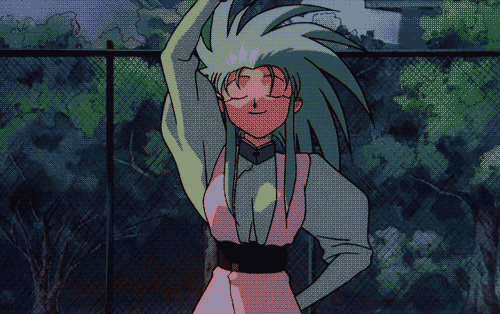
Honorable mention to FLCL (2003)
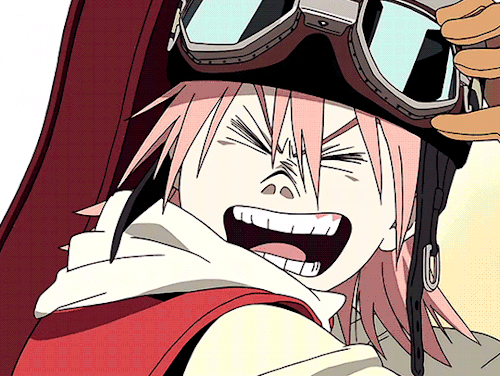
OTHER MENTIONS:
Dragon Ball, Serial Experiments Lain, Berserk, Hellsing, Perfect Blue, Chobits, Sailor Moon, Card Captor Sakura, Anything and Everything with Captain Harlock in it, Lupin the Third, Death Note, Ranma 1 1/2
126 notes
·
View notes
Text
“The Snare” Captures How Women Internalize Trauma

About two thirds of the way through The Snare, Elizabeth Spencer’s seventh novel, the protagonist, Julia Garrett, has the following exchange with her uncle, Maurice (who speaks first):
“Don’t let the past pile up, darling. It’s bad, but it’s gone and we can’t help it. Think of the wake of the boat.”
“Oh, no, that won’t work . . . it’s all around . . . around. . . .”
The line is quintessential Julia, whose every word seems matched not just to the present moment but to a personal inquiry or revelation. In this scene, she is specifically grieving the sudden death of her former lover, a wealthy (and married) Mississippi man named Martin. More broadly, though, she is articulating the root of her existential problem—the thing that, in the course of 400 pages, carries her to the brink of self-destruction—which is that Julia cannot, perhaps does not want to, escape her traumatic past.
Spencer’s gift for characterization reaches enviable depth in The Snare. On the surface, Julia Garrett is a society girl who pursues fulfillment in the seedy underbelly of post-war New Orleans. But this overarching plotline is anchored by the protagonist’s interior turmoil, which is both nebulous and rife with conflict. We spend a lot of time in Julia’s head, reflecting on her past and watching her cobble together abusive events with survivalist instincts. Chief among her preoccupations—what prompts her routine flashbacks and uncertain streams of consciousness—are her abandonment by her father and her relationship with her great-uncle and Maurice’s father, Henri “Dev” Devigny.
Though long dead at the start of the book, Dev is the subject of Julia’s love and revulsion, the figure who inspires her to consider herself both a vibrant, sensual “creature” and a whore. For Julia, Dev is “a constant heavy sun along the horizon of her spirit self,” both illuminating and blinding, comforting and oppressive. The implication is that Dev sexually manipulated Julia from the age of six, but Spencer never states this explicitly. Rather, she hews to the intimate third-person perspective that dominates the novel, an authorial choice that creates narrative tension and feels authentic to the way many women process sexual trauma. Julia cannot name what happened to her, so Spencer resists rendering it in categorical terms.
Spencer, who died in December, at age 98, had a penchant for writing characters who are concerned with their pasts. Frequently, they conduct themselves within their own historical contexts, recalling family sagas and ancient grievances amid ordinary affairs—an engagement party, a Christmas pageant, a vacation in the Blue Ridge Mountains. Often, they are Southern, reflecting Spencer’s own heritage as a native Mississippian, and as a person who, like me, was born into a cultural obsession with bearing and unravelling legacies. Early in her career, critics likened her to Faulkner, though she resisted the comparison, citing her subject as the sole similarity. In 1989, she told The Paris Review, “If my material seems like his, as I say, it must be that we are both looking at the same society.”
Read it: Ekosistem Digital
When she left the South—for Italy and, later, Canada—her fictional landscapes shifted, too, though her interest in familial burdens and societal constraints remained constant. For some readers, it was this focus that cemented her as a next-generation Faulkner. Others saw glimmers of Henry James in her tales about Americans abroad. As I make my way through her astonishing body of work, I find myself thinking most often of her friend Alice Munro, so penetrating is her insight into female experiences of complex class structures and rigid social mores.
And yet, despite the fact that her name often appears in grand company, and despite her prize-winning canon that includes nine novels, a memoir, and six collections of short stories, Spencer is largely overlooked in contemporary literary circles. Her best-known work is The Light in the Piazza, a novella she published in 1960 and later called her albatross. “It probably is the real thing,” she said. “But it only took me, all told, about a month to write, whereas some of my other novels—the longer ones—took years.”
Her trauma exists in the backdrop of her quest for self-actualization, an honest reflection of how many women move through their lives.
The Snare is one such novel. It was published nearly five decades ago, but I first encountered it late last August, while entrenched in a reading cycle that seemed pulled from a graduate seminar in #MeToo-era literature. Piled with books like Susan Choi’s Trust Exercise, Jia Tolentino’s Trick Mirror, and Julia Phillips’s Disappearing Earth, my desk signaled my devotion to contemporary examinations of gender and power. In this sense, I was primed to appreciate The Snare as a significant book, one that explores female identity with nuanced precision, and one that captures the messy and prolonged impact of sexual trauma. Immediately, I was drawn to Spencer’s deep exploration of Julia Garrett’s psyche and the way she wields narrative ambiguity to convey the detachment and confusion with which many women internalize abusive events. For all the broadening of conversations around sexual violence that has occurred over the past two years—for all the brilliant books I’ve consumed that deal explicitly and painfully with the subject—I am aware that navigating the aftermath of such a trauma is confusing and, often, intensely private. As she considers the qualities that separate her from her upper-crust society and propel her toward an electric yet dangerous and ultimately violent lifestyle, Julia Garrett struggles in isolation to understand her past. It is not surprising that Dev finds his way into her tortuous musings. “What was it Dev, the old man, had said?” she thinks, at one point. “���Passion is what you’ve either got or haven’t got. . . .’ Out of such scraps she had stuck her own truth together.”
In many ways, The Snare is a feminist novel, far ahead of its time in its handling of female sexuality and desire, as well as the influence of early and unwanted experiences. Among works aimed at deepening mainstream discussions about sexual exploitation, it becomes essential reading; but one cannot claim the subject as the book’s central concern. Probably, this is why I like it so much. What occurred between Dev and Julia slinks through her mind, never revealing itself as a certain memory and yet never receding completely. Her trauma exists in the backdrop of her quest for self-actualization, which strikes me as an honest reflection of how many women move through their lives.
It is worth noting that what is so potent to the contemporary reader barely registered with the book’s initial critics. One needs only a cursory grasp of cultural history to imagine why. The Snare was first published in 1972, a year before the term “domestic violence” entered the American lexicon, and two years before Barnes v. Train attempted to tackle workplace power dynamics. Issues of child sexual abuse hardly resonated in the public consciousness and would not garner substantial legal attention until the enactment of the Child Abuse Prevention and Treatment Act, in 1974. Spencer’s novel incorporates these themes to varying degrees, usually with the type of subtle probing that suits the introspective Julia. Specifically, Spencer’s deliberate blurring of Julia’s past trauma elicited confusion among reviewers in an era when Americans had, at best, an inchoate appreciation for the sexual autonomy of women and girls.
The novel received a lackluster review in the New York Times and a misogynistic one in Kirkus Reviews. (What the Times described as narrative complexity Kirkus labeled as melodrama, declaring that The Snare was not far removed from “Southern belle lettres.”) The Georgia Review picked up on the necessity of Spencer’s painstaking attention to her protagonist’s history and interiority—elements the Times alternatively described as “the novel’s most damaging flaw”—but determined that the structure was too elevated for the book’s thematic content. This, too, has a sexist ring, considering the great extent to which female desire propels the storyline.
The blurring of Julia’s past trauma elicited confusion in an era when Americans had an inchoate appreciation for the sexual autonomy of women and girls.
Among these pieces of criticism, what was largely agreed upon was the plot. In great or spare detail, each described the events of the book in a similar fashion: Julia Garrett, the adopted niece of Maurice and Isabel Devigny, a respectable New Orleans couple, is tired of her well-bred lifestyle. She seeks excitement with Jake Springland, an aspiring musician and somewhat ambivalent disciple of a religious zealot. With Jake, Julia enters a world of late-night jazz shows and drug dealers and, soon, murder. The novel begins in the 1950s and spans at least a decade, thrusting a clash of societal standards into the backdrop of Julia’s experience. (Her roommate, Edie, a girl from “some dusty little dried-up town,” is her prudish foil.) Julia is, as the book’s title suggests, resisting the snare of the stifling and polite realm in which she was raised; but she is caught nonetheless by a confluence of her own impulses.
The preeminent Spencer scholar, Peggy Prenshaw, further elucidated the central themes of The Snare in 1993, when she wrote an introduction to the book on the occasion of its paperback release. “Julia Garrett,” Prenshaw writes, “seems a misfit, a woman enlivened by sexual experience and nearly destroyed by it, a woman bored by status-seeking and acquisitiveness, whose indifference brings her to the edge of hunger and homelessness.” She goes on to explain that the novel’s setting in New Orleans mirrors Julia’s seductive power and dueling instincts. Like Julia, Prenshaw says, the city is steeped in manners and tradition, but beneath its glossy exterior it is an exotic, indulgent place.
Prenshaw also references the novel’s mixed critical reception, noting the issues reviewers had with narrative ambiguity, but she does not fully explore the resonance of this authorial choice with the book’s violent plot points. Spencer’s rendering of Julia’s darkest moments is frenetic and fragmentary, allowing certain mysteries to rest in the reader’s mind as uncomfortably as they do in Julia’s. In these scenes, the events are clear, but their details are often foggy, punctuated by an image here, a sensation there. We see, for example, the flash of a blade held to Julia’s neck and glimpse, through euphemistic language, the shame she associates with what follows. As in, “After that . . .” and “I’m just going to call it an awful headache.” For Julia, what is contained in the words that and it is unspeakable, even as it holds dominion over her identity.
Crucially, vagueness distinguishes Julia’s memories of her relationship with Dev. Speaking of her protagonist in 1990, Spencer said, “Her early experience with her guardian mentor, . . . a French Cajun man who may or may not have seduced her, had a profound effect on her.” Prenshaw interprets this effect decisively. “The indisputable fact seems to be that Julia does not regard the relationship with Dev as injurious. If corrupting, it was a necessary and inevitable introduction to the ‘crooked world.’” This statement aligns imperfectly with my own impression, because it ignores the yearning that is so critical to Julia’s idea of herself. She does not want to regard the relationship with Dev as injurious. She wants to imagine it as inevitable.
Spencer makes clear that, for Julia, it is easier to live with a terrible thing when it is remembered indistinctly. Julia’s past with Dev haunts the novel because it is essential to how she views herself, and yet she is unable to define it. Violence and sexual exploitation pervade her adult life, too, and yet she never names it as such. Rather, she absorbs it all with a pronounced detachment, as though each experience is the logical conclusion of who she is in the world. After the doctor for whom she briefly works as a receptionist chases her around the office, she thinks: “. . . life was more peaceful than not with him, now that he’d made his pass.” After Jake Springland, her musician boyfriend, rapes and beats her, she thinks: “Why didn’t I find somebody good?” and then concludes that “she hadn’t because she hadn’t wanted to.” She is kidnapped twice, thanks to her association with Jake, and subjected to torture. After the first time, she thinks: “It was something in me . . . Something that wanted to go down forever, to hit the absolute muddy bottom where there’s nothing but old beer cans, fishhooks and garbage.” After the second time, she thinks: “She would gladly live like an animal, simply, instinctively, for the day only.”
For Julia, it is easier to live with a terrible thing when it is remembered indistinctly.
Julia’s enthusiasm for New Orleans and its various vices—her sensual and subversive nature—is palpable and seemingly within her control. From the start she is an intelligent woman who knows her sexual power. But as we navigate the conflicting aspects of her mentality, we learn that her empowerment is marked by shame. At times, she reduces herself to her sexuality. Dressing for a courtroom gallery: “Might as well try to de-sex herself, she thought, as stamp out her natural looks.” Her early sexualization by Dev forms a critical aspect of her identity and self-worth, convincing her that she is incongruous with anything virtuous. She thinks, “The idea of goodness beckons forever to those who can’t have it, but once they catch up to it by luck or accident, they immediately feel uneasy, restless, miserable.”
This vivid interiority is what is largely missing from any summary or critical analysis of The Snare. How Julia decodes her own experiences is a vital aspect of the novel that seems only to have puzzled reviewers in 1972 and failed to thoroughly engage scholars in the following decades. I only learned of the book because several people recommended it to me. Each had read my work and assumed I would appreciate Spencer’s meticulous characterization of Julia Garrett. But at some early point in my first reading, Julia began to resonate as more than a technical feat. We are wildly different people, and yet I identify with her tendency toward self-examination through imperfect recollections. I possess the kind of memory that blurs even the recent past. It recalls the worst things dimly and everything else with rosy nostalgia. This has the effect of making me suspicious of my negative or painful emotions. I am unskilled at relaying the detailed origins of my deepest wounds without a large amount of ambiguity. Spencer captures this deficiency, too. After Jake assaults and abandons her, Julia says, “I don’t think I was even born a virgin.” Her effort to make sense into the plainly nonsensical seems to me like an inherited impulse, something derived from generations of cultural stagnation around gender-based violence.
Months before her death, I spoke with Elizabeth Spencer over the phone. She talked about the months she spent in New Orleans, researching the novel’s setting, and recalled her use of narrative ambiguity as the deliberate choice I had assumed it was. And yet, I absorbed from her a sense that her fixation on Julia’s past diverged from my own. “I don’t spend too much time psychoanalyzing,” she said. I felt somewhat disappointed by her answer, at first. So much of Julia’s persona appears drawn from an intellectual understanding of the functional ways in which human beings process trauma. But maybe Spencer’s more intuitive approach is what accounts for her novel’s brilliance. Perhaps her resistance to determining direct cause and effect is what allowed her to craft such a complicated and authentic character. Julia is not whittled into a particular set of psychiatric ailments, and her interior current is rich and evolving, never cyclical, never wholly diminishing. Spencer allows her protagonist a limitless quality, that of a woman constantly interpreting and reinterpreting her place in the world through her experiences. Who among us isn’t?
About the Author Caroline McCoy’s work appears or is forthcoming in The Georgia Review, Blackbird, Lit Hub, The Bitter Southerner and others. She has received residencies and fellowships from Crosstown Arts, in Memphis, and Emerson College, where she earned her MFA in 2019.
Source: electricliterature.com/the-past-is-present-in-the-snare/
0 notes
Text
Agoraphobia, the Mixtape
“Stones in My Pathway” by Robert Johnson
Robert Johnson’s “Stones in My Pathway” was not popular in its time--1937--but became largely recognized after the blues revival period. Johnson has been socially constructed on behalf of scholars and listeners alike as a so-called “lonesome blues man”, an embodiment of authentic rural blues sound. The lack of success of “Stones in My Pathway” when it was originally recorded was conceptualized later as testament to Johnson’s distance from the marketplace. Such logic posited Johnson as somehow more legitimate and original than his more popular contemporaries. The song was short and simple in that it featured only Johnson’s voice and sole guitar accompaniment. A metaphor for sexual pleasure obstructed like stones in a pathway, the song demonstrated desperation and despair: the “authentic” stereotype to blues audiences.
“Empty Bed Blues” by Bessie Smith
Whereas Johnson was a wandering bluesman, Bessie Smith was just the opposite: a musician that produced commodified blues. Bessie Smith’s “Empty Bed Blues” was one of the biggest hits of the singer’s career. The song, like its artist, was largely marketed to black audiences and performed via vaudeville circuits. “Empty Bed Blues” is an explicitly sexual song filled with funny innuendos and accompanied by trombone and piano. With big-bodied character and metaphorical wit, Bessie Smith unapologetically owns her sexuality. The song is in stark contrast to Stones in My Pathway: six minutes long with robust accompaniment and Charlie Green’s trombone accenting the hilarious lyrics. Similarly, while scholars paraded Johnson’s anguish and lack of market success, they criticized Smith’s Empty Bed Blues for being sexually explicit and for its commodification to black audiences at the time. Though in reality both songs and their artists spoke of sex in the language of the blues, and both did see monetary and popular success at some point, they are caught up in the audience’s debate over authenticity and the market.
“Afro Blue” By Robert Glasper
Robert Glasper’s adaptation of Afro Blue sung by Eryka Badu is an example of Glasper’s reach beyond jazz into R&B music as he strayed from the traditional Jazz arrangement of this song. Glasper was known for exploring genres beyond jazz and for that was critiqued by many for “selling out”. However, he argued he was being true to his desires to explore, and not doing so would be the real definition of “selling out”. Glasper’s Afro Blue has a heavy drum beat accompanied by sparse piano and the occasional riff on a wind instrument. The heavy repetitive beat keeps a steady laid back new age rhythm.
“Love Theory” By Kirk Franklin
Love theory by Kirk Franklin is a funky R&B “gospel” with hip hop influence. The inclusion of a choir in the song is a powerful addition as it is representative of traditional gospel choir songs one would hear in a church. Kirk is someone who fought to reach a wider audience, specifically the youth, by collaborating with artists such as “salt-n-pepa” and creating music that strayed from traditional gospel instrumentals to including pop, R&B and hip hop audiences.
“F**k the Industry” By Solange Knowles
Through a leaking of her unofficially released mixtape, singer Solange Knowles adheres to the theme of agoraphobia breaking the musical norms of what the industry depicts as successful female R&B artists of the 90s-2000s. She calls out her own successful sister Beyonce, Ashanti, Jennifer Lopez, aka JLo, and Mary J. Blige as the norm who all represent a similar type of style that includes precisely planned out aesthetics of Benz cars, carefully matched and coordinated hair, make-up, and clothing saying that she refuses to go along with the mainstream style just for sales and chart-topping popularity. As she claims her power in being original and true to self in her lyrics she criticizes the industry and record labels for not giving her the same attention, credit, and time simply because she is not pushing this fake alter-ego image. Using lyrics like, “I’ll never be picture perfect like Beyonce” and, “I’m sorry I ain’t in the Benzes in my videos / I’m sorry I ain’t even really trying to match my clothes … No, I don’t trust the crowd just to walk around it / So I’m writing this letter to the industry / It says “Fuck you, signed sincerely” one gets a clear picture of how she calls out the industry for its portrayal of artistry that only serves to sell this commodified version of what they want music to sound like.
“Apeshit” By The Carters
“Apeshit” by The Carters represents the theme of agoraphobia since we see Beyonce and Jay-Z, the most powerful, influential Black musician couple of modern time taking advantage of their messy extra-marital affair debacle that spread like wildfire across social media platforms like Twitter, Instagram, and Facebook, as a means of commodification turning their life into a juicy love story that everyone wants a piece of. In the song we hear a different style of rap from both artists which we have never heard them submerge themselves in before until now. They take on Atlanta-styled trap music using ad-libs like “skrrt, skrrt, skrrt/jumpin’, jumpin’, hey, hey” from Migos’ group member Quavo who is widely known for his extremely simple rap style of talking about women and money in objectifying ways. Before this album, Beyonce had not really completely submerged herself in trap music and culture and once the album was dropped, she was criticized for what people felt was “selling-out.”
“Respect” By Aretha Franklin
Aretha Franklin, although one of the greatest singers of all time and considered the Queen of Soul still conformed to the cultural trends of society during her musical career. While she began her musical career as a gospel singer, she was only able to attain modest success at best from this. Consequently, she decided to make the transition into a soul singer and ultimately reeked the benefits. One of her most iconic songs released was “Respect” in the sixties. The tune, a remix of Otis Redding’s original version, touches upon prevalent issues during this era such as feminism and civil rights movements. Simple but blissful, from the steady drum beat separated by intermittent horns, to the back-up vocals, to the saxophone solo, the song is energetic and one demanding the idea of respect which is the theme Franklin is trying to express. Released during a pivotal time, the song swept the nation by their feet, giving average people the confidence to demand the respect they deserve. From one perspective though this can be looked at as Aretha selling out by trying to use current events as a way to enhance her popularity and monetary value.
“Soon All Will Know” By Wynton Marsalis
Wynton Marsalis is a globally recognized musician who has performed in an expansive array of musical groups. Unlike many artists who over the duration of their career conform to the likings of society, Wynton has maintained a fear of the marketplace and stayed loyal to the principals of Jazz. One of his most popular songs which implicates the transcending message jazz music is trying to portray is “Soon All Will Know” from his Grammy winning album ‘Standard Time Vol 1’. In the song, Marsalis elegantly and effortlessly leads his quartet in creating a relaxing type of mood by dancing around the pianist and drummer with his trumpet. Marsalis’s ability to continuously produce immaculate compositions and refusal to alter his emotionally evoked trumpet playing style has allowed him to remain significant within the classical jazz world for nearly four decades.
0 notes
Text
New Post has been published on PBA-Live
New Post has been published on http://pba-live.com/west-is-best-but-stars-hold-the-key-to-the-future/
West is best, but stars hold the key to the future
For decades, a stream of talent with big aspirations has been migrating west across the Appalachians and the Mississippi River. History, mystique and the nation’s most hallowed institutions still reside on the Eastern Seaboard and in the old industrial Midwest, but for big upside and a high ceiling, go west.
The phenomenon of highly skilled labor leaving one region for another is what economists call human capital flight or “brain drain.” Over the past 20 years, the NBA has experienced a game drain as the league’s biggest stars have disproportionately landed in the Western Conference.
When the Indiana Pacers shipped Paul George to the Oklahoma City Thunder on June 30, the current outflow of talent from East to West swelled to a tsunami. Thirteen of the top 14 players in ESPN’s November 2016 installment of #NBArank will open the 2017-18 season in the Western Conference. The only holdout is LeBron James, who is reportedly contemplating a move to Los Angeles next summer, when his contract expires in Cleveland.
It naturally follows that an outsized share of the league’s best teams play in the Western Conference. The West has beaten the East head-to-head in 16 of the past 17 seasons. In adjusted net rating, which weights a team’s overall efficiency for strength of opponent, the top five teams in the league last season all reside in the West. Of the top five teams in adjusted net rating over each of the past five seasons, only four of those 25 hail from the Eastern Conference. For all the dominance the West has displayed over the East, it’s most pronounced at the very top.
Powerful forces in the NBA have brought us to this point — among them superior management, higher expectations and plain ol’ luck. But it’s an even mightier force, the motives of star players, as demonstrated this month by Gordon Hayward, that can help the NBA rediscover parity between West and East. Is the West superior by luck or design?
The basic laws of probability dictate that in a league composed of 30 teams in two conferences there will be periods when one dominates the other. And because league rosters are relatively stable from season to season, once a conference gains an edge, it can sustain it over time through inertia. For instance, the East enjoyed an advantage during the entire span of the 1980s, when Boston, Philadelphia, Milwaukee and later Detroit consistently racked up 50-plus-win seasons.
The West’s reign of today has an air of permanence about it, as if its superiority can’t be accounted for by simple chance. But if the disparity is more than that, then what is it?
Regarding conference imbalance, Occam’s razor would suggest that better teams are simply better managed. Good players don’t stumble their way onto rosters by accident. Their talents are identified and their rights are acquired. They develop their skills in a specific environment, one shared by teammates, coaches, management, medical and performance experts and all kinds of support staff.
The better the operation, the more successful the team. Over time, elite organizations tend to retain the best players and/or find new blood, even if the process requires a couple of lean seasons while the place is being renovated. All of that starts at the top.
“There are good owners in both conferences, but collectively there are better owners in the West,” Rockets general manager Daryl Morey says. “Players are getting wise to owners being an important selection criteria.”
In his statement following the announcement of his new four-year, $170 million extension on Saturday, James Harden said, “[Owner Leslie Alexander] has shown he is fully committed to winning, and my teammates and I are going to keep putting in the work to get better and compete for the title.”
The East certainly boasts some standout owners — Micky Arison in Miami, Wyc Grousbeck in Boston, to name a couple. But from the Texas triumvirate to the steady Miller family in Utah, the depth chart of the West’s owners, just like its superstars, is more impressive.
Smart ownership yields smart management, and the most innovative, competent — and stable — front offices have been concentrated in the West for a while now. Continuity is the mother’s milk of the NBA, and the regimes in San Antonio and Dallas (ranked first and second in wins since 2000) have been in place for eons. Two big winners this offseason, Sam Presti in Oklahoma City and Morey in Houston (the Rockets and Thunder rank fifth and sixth in wins since 2000) are both a decade into their tenures. Third and fourth place go to the Lakers (Mitch Kupchak presided from 2000 until 2017), and Miami (Pat Riley has ruled since the first term of the Clinton administration).
The suggestion here is that if an organization wants to reap a long, bountiful era of milk and honey, and all the rest of it, it should install competent managers in the executive suites and provide them with a long runway. But is longevity for a front office the catalyst for winning, or is this the halo effect at work? Do elite teams win big because owners provide management teams decades of job security, or do those front offices get 10, 15, 20 years of trust because their teams are successful? The Warriors and the broken window theory
The Golden State Warriors have set the entire NBA on edge, particularly those franchises that have been deliberately constructing their teams to contend during the latter half of this decade. The Dubs have sent a message: If you want to contend in the West — hell, if you just want a chance to host a playoff game in May — you better load up.
That’s exactly what the Rockets did in acquiring Chris Paul, bolstering their vulnerable defense with PJ Tucker and feverishly managing their spreadsheet to add even more. The Spurs, determined not to squander Kawhi Leonard’s prime, added Rudy Gay and brought back key contributors instead of retreating into a soft rebuild to ready themselves for a time after the dissolution of the Holy Warriors Empire. Oklahoma City saw a chance to add a second top-10 player and pounced.
Meanwhile, back East, 41 wins will likely land you a spot in the playoffs, as it did last season for Chicago (though not Miami).
“When a conference is weak, teams in that conference don’t have to invest as much to succeed,” Mavericks owner Mark Cuban said via email last week. “Nor is there as much pressure to succeed. That impacts the decision-making process.”
Call it the Soft Drudgery of Low Expectations or even the Broken Conference Theory, whereby a conference that falls into disrepair is more likely to continue its slide into oblivion. In an environment in which a sub-.500 record could net a team two home playoff dates, and a 45-win season practically pencils a team into the conference semis, it’s not surprising to see a whole bunch of teams behave like the regular season is a pass-fail course. This effect leads the East to function as a warehouse store for treadmills of mediocrity, where a .500 record buys you a bargain.
Perhaps there’s an evolutionary component to this idea. College coaches routinely point to scheduling challenging out-of-conference games as a means to strengthen their teams for postseason play. For Western Conference squads that can hardly go a week without seeing a Warriors, Spurs, Rockets or another .600 West foe on the docket, their merciless schedule demands constant playoff-quality execution. All the while, Eastern Conference teams get to scheme against the confederation of the middling.
Salt Lake City, New Orleans, Memphis and Oklahoma City rank as the NBA’s only metro areas shy of 1.5 million people, according to the U.S. Office of Management and Budget. But that hasn’t stopped the Jazz, Grizzlies and Thunder from, season after season, turning out a consistent product in a league in which market size has huge implications for local broadcast revenue and free-agent recruitment. Spend 10 minutes with top team business execs such as the Jazz’s Steve Starks and the Grizzlies’ Jason Wexler, and one thing is clear: There’s an organizational imperative to scratch, claw and do whatever it takes to maintain relevance, even if it means bowing out with dignity in the conference semifinals to a juggernaut like Golden State.
It’s also easy to forget that San Antonio qualifies as a bottom-10 NBA market in size (the nation’s No. 31 Nielsen market, just behind Hartford, Connecticut), because the Spurs long ago stopped behaving like a have-not. Portland, the league’s No. 23 television market, might not have enough high-end hotel rooms to host an All-Star Game, but the Trail Blazers have compiled a .564 winning percentage since Paul Allen bought the team in 1988.
For all the hand-wringing over the precarious state of small-market NBA franchises against the big-market bullies, the gap between big and small isn’t a fraction of the chasm between West and East. The question is: Why is the disparity so hard to undo? The Matthew Effect
For everyone who has will be given more, and he will have an abundance. But the one who does not have, even what he has will be taken away from him.
This verse from the Book of Matthew inspired a well-known aphorism: The rich get richer and the poor get poorer. Sociologist Robert K. Merton gave it a name: the Matthew Effect. If the past several years are any indication, the Matthew Effect has found a sturdy vessel in the NBA.
Ostensibly, the NBA doesn’t try to perpetuate inequality between teams or conferences. With the draft, the NBA employs an incentive structure that hands the best incoming talent to terrible teams. If those teams are disproportionately located in the Eastern Conference — or, for that matter, wear blue as their primary color or play in cities whose names start with letters in the first half of the alphabet — the draft system is, in practice, supposed to make the poor richer. For whatever reason, these remedies aren’t having their intended effect.
In 2010, a new variable changed the equation when the Big Three joined forces in Miami — a somewhat ironic turn given that the Heat play in the East, as did the three stars who joined forces, LeBron James, Dwyane Wade and Chris Bosh.
Theoretically, the salary-cap structure is one of the NBA’s mechanisms for discouraging a concentration of power, but James exerted his self-determination as the talent who drives the talent of the league. He wanted to play with two hand-picked All-Stars, and aided by the spreadsheet jiu-jitsu of Pat Riley and Andy Elisburg in Miami’s front office, that’s exactly what happened. In the seven years since, James’ contemporaries have adopted the same strategy.
“Today, for players where the money is equal between destinations, ‘Which superstar am I playing with?’ are Nos. 1, 2 and 3 in selection criteria,” Morey says. “Only after that comes owners, management, coach and city.”
If the brightest stars are magnets that attract other superstars, then the more talented conference will effectively compound its advantage. Kevin Durant joins Steph Curry in Oakland, while Chris Paul partners with James Harden in Houston. Paul George might not stay in Oklahoma City, but the presence of Russell Westbrook means that, if things work out this season, both guys can re-up for top deals and assure they’ll be playing with a fellow superstar.
Try as the league might to declare the terms for competition, superstars are now running the show — and they want to play in tandems and trios. Superstars can fix this
As the gap between the West and East widens, calls for eliminating conferences altogether grow louder. Sensible proposals have been made and Adam Silver said in 2015 the league would “take a hard look” at a playoff system that accepts the top 16 teams overall, regardless of conference standings.
Such a system could burden teams with brutal travel. The lower seed in a seven-game series between Portland and Miami would log 16,200 miles in six cross-continental flights over two weeks. For Boston-Los Angeles, it’s 15,600. That volume of travel isn’t conducive to world-class basketball when the games matter most, nor to good health.
Time might be a cure, as Boston, Philadelphia and Milwaukee are poised to be very competitive for a very long time. At the same time, Minnesota, Denver and the Lakers figure to rejoin the living in the West over the next few seasons. If LeBron makes good on reports that he’s eyeing Los Angeles, the entire enterprise might capsize.
Stars like LeBron hold the key, and they might be the best corrective for conference imbalance. According to multiple sources close to the Gordon Hayward sweepstakes, a key pitch point in the recruitment process from Boston — and to a lesser extent Miami — was a shorter line to compete for a conference title and beyond.
Around Hayward, Utah built an exemplary culture with classy ownership, standout management and a dedicated coach. Yet the Jazz were up against an impossible structural challenge — they couldn’t offer him the fast track Boston could. In the East, Hayward is an even-money bet to snag one of the three starting frontcourt spots in the 2018 All-Star Game; in the West, he’s a cautionary tale.
However much Hayward was drawn to Brad Stevens or the Celtics mystique, Boston’s trump card was opportunity. “Where can I win?” is a question inextricably linked with “Which superstar am I playing with?” At what point do other top-20 players entertaining those questions examine the landscape, spot the market inefficiency and make the same call?
When they do, this conversation is over.
Source: http://www.espn.com/nba/story/_/id/19959615/west-best-stars-hold-keys-future-kevin-arnovitz
0 notes